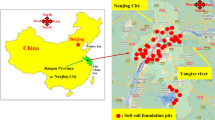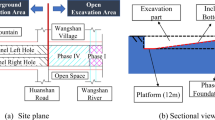Abstract
In this study, statistical analysis and numerical simulation based on Shanghai and Suzhou soft ground pit data is used to analyze the laws of maximum deflection of the diaphragm wall, maximum ground settlement, and their relationship. The results show that the deformation characteristics of pits are different in the two regions, and the deformation of pits in Shanghai is greater. The maximum deflection of the diaphragm wall ranges from 0.066 to 0.960 %H, and the average value is 0.364 %H in Shanghai. In Suzhou, maximum deflection ranges from 0.05 to 0.30 %H, and the average value is 0.16 %H. The maximum ground settlement in Shanghai spans from 0.079 to 0.510 %H, the average value is 0.248 %H, and it ranges from 0.03 to 0.168 %H. Meanwhile, the average value was 0.089 %H in Suzhou. These results provide a useful reference for the design and construction of excavation projects in both regions.












Similar content being viewed by others
References
Chen K, Yan SW, Sun LQ, Wang YW (2016) Analysis of deformation of deep foundation pit under excavation unloading condition. Rock Soil Mech 37(4):1075–1082
Ding YC, Wang JH, Xu B (2009) Three-dimensional numerical analysis of braced excavation based on FLAC3D. J Shanghai Jiaotong Univ 43(6):976–980
Goldberg DT, Jaworski WE, Gordon MD (1976) Lateral support system and underpinning. Report No. FHWA-RD-75-129, Volume 2, Federal Highway Administration, Washington
Huang MS, Wang WD, Zheng G (2012) A review of recent advances in the underground and deep excavations. Chin Civil Eng J 45(06):146–161
Huang P, Liu GB, Huo RK (2015) Parameter analysis of zoned excavation in soft soil area. J Cent South Univ (Sci Technol) 46(10):3859–3864
Li JJ, Wang WD, Di G, Wu JB (2007) Analysis of the influence of excavation engineering on additional deformation of adjacent buildings. Rock Soil Mech 28(S1):623–629
Li WX, Zhao ST, Liang XL, Wang J (2005) Fuzzy model for analysis of ground movement and deformation due to deep excavation. Chin J Rock Mech Eng 24(S2):5495–5498
Liao SM, Wei SF, Tan Y, Liu JX (2015) Field performance of large-scale deep excavations in Suzhou. Chin J Geotech Eng 37(3):458–469
Lin H, Cheng JY, Guo C, Liu QY (2015) Numerical analysis on influence of foundation pit excavation on deformation of adjacent existing tunnel. J Central South Univ (Sci Technol) 46(11):4240–4247
Liu GB, Jiangrebecca J, Ngcharles WW, Hong Y (2011) Deformation characteristics of a 38m deep excavation in soft clay. Can Geotech J 48(12):1817–1828
Liu JG, Zeng YW (2006) Application of FLAC3D to simulation of foundation excavation and support. Rock Soil Mech 27(3):505–508
Liyanapathirana DS, Nishanthan R (2016) Influence of deep excavation induced ground movements on adjacent piles. Tunn Undergr Sp Tech 52:168–181
Lu PY, Han LJ, Yu Y (2008) Finite element analysis of temperature stress in strut of foundation pit. Rock Soil Mech 29(5):1290–1294
Mana AI, Clough GW (1981) Prediction of movements for braced cuts in clay. Geotech Sp 107(118):1840–1858
Mu YJ (2009) Monitoring analysis on exterior-protected construction of foundation-pit of Subway in Suzhou. J Shijiazhuang Tiedao Univ (Nat Sci) 22(3):38–43
Ou CY, Hsieh PG, Chiou DC (1993) Characteristics of ground surface settlement during excavation. Can Geotech J 30(5):758–767
Sun Y, Xu YS, Shen SL, Sun WJ (2012) Field performance of underground structures during shield tunnel construction. Tunn Undergr Sp Tech 28(3):272–277
Tan Y (2014) Spatial corner effects of long and narrow multipropped deep excavations in Shanghai soft clay. J Perform Constr Facil 28(4):1–17
Tan Y, Wang D (2013a) Characteristics of a large-scale deep foundation pit excavated by the central-island technique in Shanghai soft clay. I: bottom-up construction of the central cylindrical shaft. J Geotech Geoenviron 139(11):1875–1893
Tan Y, Wang D (2013b) Characteristics of a large-scale deep foundation pit excavated by the central-island technique in Shanghai soft clay. II: top-down construction of the peripheral rectangular pit. J Geotech Geoenviron 139(11):1894–1910
Tan Y, Kang ZZ, Wei B, Deng G (2016) Case study on deep excavation for metro ventilation shaft in Shanghai soft clay. J Zhejiang Univ (Eng Sci) 50(6):1048–1055
Wang HR, Wang WD, Xu ZH (2012) Simplified method for evaluating excavation-induced impact on surrounding environment based on numerical analysis. ChinJ Geothch Eng 34(S1):108–112
Wang JH, Xu ZH, Wang WD (2010) Wall and ground movements due to deep excavations in Shanghai soft soils. J Geotech Geoenviron 136(7):985–994
Wang LM, Zeng MS, Chen YG (2000) Monitoring analysis of surrounding building and retaining structure in deep excavation engineering. Build Sci 16(2):35–37
Wang WD, Xu ZH (2010) Strength reduction approach for analyzing safety against basal heave of circular deep excavations. J Build Struct 31(5):195–201
Wang XJ (2012) Analysis of retaining wall deformation for deep and big foundation pits of podium in Shanghai tower. ChinJ Geothch Eng 31(2):421–431
Wang YG (2007) Analysis on deformation and stability of a foundation pit of Suzhou Xianrendaganghub project: [dissertation]. Hohai University Nanjing
Wang WD, Shen J, Weng QP, Wu JB (2006) Analysis and countermeasures of influence of excavation on adjacent tunnels. Chin J Geothch Eng 28(S1):1340–1345
Wu CJ, Chen JJ, Ye GL, Wang JH, Zhou HB (2010) Deformation characteristics of foundation pits of subway stations in Suzhou. ChinJ Geothch Eng 32(S1):458–462
Wu YY (2016) Research on environment impact and influential partition by excavation in Suzhou metro pit engineering: [Dissertation]. Southeast University, Nanjing
Xia C, Liu XZ (2014) Case study of settlement of adjacent buildings caused by excavation of a deep foundation pit. ChinJ Geothch Eng 36(S2):479–482
Xu C, Chen Q, Wang Y, Fang T (2015) Dynamic deformation control of retaining structures of a deep excavation. J Perform Constr Facil 30(4):04015071
Xu NW (2008) Numerical simulation with FEM on deep foundation excavation and timbering of metro station: [Dissertation]. Dalian University of Technology, Dalian
Xu ZH, Wang WD (2010) Selection of soil constitutive models for numerical analysis of deep excavations in close proximity to sensitive properties. Rock Soil Mech 31(1):258–264
Xue LY, Yang WS, Li RN (2013) Discussion and analysis of accident reasons of deep foundation pits. Chin J Geothch Eng 35(S1):468–473
Yang M, Lu JY (2010) Estimation of ground settlement aroused by deep excavation. Chin J Geothch Eng 32(12):1821–1828
Yang X, Liu G (2017) Performance of a large-scale metro Interchange station excavation in Shanghai soft clay. J Geotech Geoenviron 143(6):05017003
Zhang DD, Song CY, Chen LZ (2013) Numerical evaluation of land subsidence induced by dewatering in deep foundation pit. J Shanghai Jiaotong Univ 18(3):278–283
Funding
The authors gratefully acknowledge the financial support from the National Natural Science Foundation of China (41702326), the National Postdoctoral Program for Innovative Talents (BX201700113), the China Postdoctoral Science Foundation (2017M620205), the Natural Science Foundation of Jiangxi Province (20171BAB206022), the State Key Laboratory for GeoMechanics and Deep Underground Engineering, China University of Mining & Technology (SKLGDUEK1703), the Technology Project Founded by the Education Department of Jiangxi Province (GJJ160675), the Innovation Fund Designated for Graduate Students of Jiangxi Province (YC2018-S315), and the Innovative Experts, Long-term Program of Jiangxi Province.
Author information
Authors and Affiliations
Corresponding author
Additional information
Editorial handling: M. Karakus
Rights and permissions
About this article
Cite this article
Li, S., Huang, Z., Zhao, K. et al. Comparative analysis of pit deformation characteristics in typical region soft soil deposits of China. Arab J Geosci 12, 376 (2019). https://doi.org/10.1007/s12517-019-4534-6
Received:
Accepted:
Published:
DOI: https://doi.org/10.1007/s12517-019-4534-6




